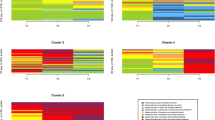Abstract
This study investigates selective participation by area deprivation in two population-based, nationally-representative surveys of children aged 5–16 years in England. We analysed the English participants (N = 22,903) in the British Child and Adolescent Mental Health Surveys, conducted in 1999 and 2004. The surveys recruited parents, teachers and children, allowing us to calculate participation rates for all three types of informant, with particularly detailed analyses possible for parents. Area-deprivation was assigned using Indices of Multiple Deprivation, 2004. We found that parents, teachers and children from more deprived areas were all substantially less likely to participate, with participation 8–9% lower in the most deprived areas than in the least deprived areas. There was substantial heterogeneity in the effect of deprivation on different types of parental non-participation, with a strong association for overall non-contact but none for overall non-cooperation. Refusal to participate in response to opt-out letters showed the opposite gradient to all other forms of non-participation, with individuals from less deprived areas being more likely to opt out. These findings indicate that the deprivation level of area of residence predicts non-response in multiple types of informants, which may exacerbate bias when estimating the prevalence of health outcomes. Furthermore, the magnitude and the direction of this may depend on the recruitment method used. Differential response by area deprivation may therefore be worth measuring in any survey.


Similar content being viewed by others
Abbreviations
- B-CAMHS:
-
British Child and Adolescent Mental Health Surveys
- CBR:
-
Child Benefit Register
- IMD:
-
Index of Multiple Deprivation
- ONS:
-
Office for National Statistics
- SDQ:
-
Strengths and difficulties questionnaire
References
Beerten R. The effect of interviewer and area characteristics on survey response rates: an exploratory analysis. Survey Methodol Bull. 1999;45:7–15.
Groves M, Couper R. Nonresponse in household interview surveys. New York: Wiley Interscience; 1998.
Slattery ML, Edwards SL, Caan BJ, Kerber RA, Potter JD. Response rates among control subjects in case-control studies. Ann Epidemiol. 1995;5(3):245–9.
Martin J, Matheson J. Responses to declining response rates on government surveys. Survey Methodol Bull. 1999;45:33–7.
Morton LM, Cahill J, Hartge P. Reporting participation in epidemiologic studies: a survey of practice. Am J Epidemiol. 2006;163(3):197–203.
Plewis I, Ketende S. Millennium cohort survey first survey: technical report on sampling, 3rd ed. London: Centre for Longitudinal Studies, Institute of Education; 2004.
Plewis I, Ketende S. Millennium cohort survey: technical report on response. London: Centre for Longitudinal Studies, Institute of Education; 2006.
Smith AG, Fear NT, Law GR, Roman E. Representativeness of samples from general practice lists in epidemiological studies: case-control study. BMJ. 2004;328(7445):932.
UK Childhood Cancer Study Investigators. The United Kingdom Childhood Cancer Study: objectives, materials and methods. Br J Cancer. 2000;82(5):1073–102.
Angus VC, Entwistle VA, Emslie MJ, Walker KA, Andrew JE. The requirement for prior consent to participate on survey response rates: a population-based survey in Grampian. BMC Health Serv Res. 2003;3(1):21.
Tickle M, Milsom KM, Blinkhorn AS, Worthington HV. Comparing different methods to detect and correct nonresponse bias in postal questionnaire studies. J Public Health Dent. 2003;63(2):112–8.
Medical Research Council. MRC ethics guide: medical research involving children. 2004 [cited 11th March 2008]; Available from: http://www.mrc.ac.uk/Utilities/Documentrecord/index.htm?d = MRC002430.
Leon DA, Saburova L, Tomkins S, McKee M, Shkolnikov VM. Alcohol consumption and public health in Russia. Lancet. 2007;370(9587):561.
Green H, McGinnity A, Meltzer H, Ford T, Goodman R. Mental health of children and young people in Great Britain, 2004. Palgrave MacMillan; 2005.
Meltzer H, Gatward R, Goodman R, Ford T. Mental health of children and adolescents in Great Britain. London: The Stationery Office; 2000.
Ford T, Goodman R, Meltzer H. The British Child and Adolescent Mental Health Survey 1999: the prevalence of DSM-IV disorders. J Am Acad Child Adolesc Psychiatry. 2003;42(10):1203–11.
Goodman R. The strengths and difficulties questionnaire: a research note. J Child Psychol Psychiatry. 1997;38(5):581–6.
The American Association for Public Opinion Research. Standard definitions: final dispositions of case codes and outcome rates for surveys. Lenexa, Kansas: The American Association for Public Opinion Research; 2000.
Office of the Deputy Prime Minister. The English Indices of deprivation 2004—summary (revised). 2004 [cited 26 Feb 2008]; Available from: http://www.communities.gov.uk/documents/communities/pdf/131209.
Office of the Deputy Prime Minister. Indices of deprivation 2004—Population Denominators. 2007 [cited 26th Feb 2008]; Available from: http://www.communities.gov.uk/archived/general-content/communities/indicesofdeprivation/216309/indicesdeprivation/.
Rubin DB, Schenker N. Multiple imputation for interval estimation from simple random samples with ignorable nonresponse. J Am Stat Assoc. 1986;81:366–74.
Acknowledgements
Many thanks to Dave Leon and Robert Goodman for their input in the design of this research, and their comments on drafts of this paper. Thanks also to Mike Kenward for advice given on the statistical methods used. The B-CAMHS surveys were carried out by the Office for National Statistics, and paid for by the Department of Health, the Scottish Health Executive, and the National Assembly for Wales (1999 survey only). AG carried out the analyses for this paper while funded by an Economic and Social Research Council/Medical Research Council Research Degree Studentship.
Author information
Authors and Affiliations
Corresponding author
Electronic supplementary material
Rights and permissions
About this article
Cite this article
Goodman, A., Gatward, R. Who are we missing? Area deprivation and survey participation. Eur J Epidemiol 23, 379–387 (2008). https://doi.org/10.1007/s10654-008-9248-0
Received:
Accepted:
Published:
Issue Date:
DOI: https://doi.org/10.1007/s10654-008-9248-0




